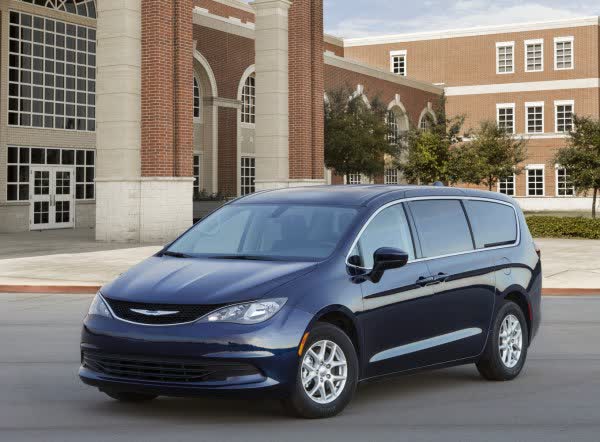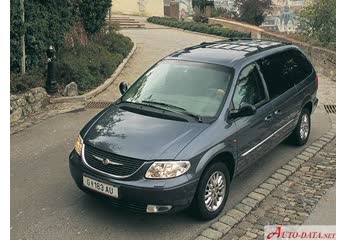Everything you need to know about specifications and performance - Chrysler Voyager 2024 - 3.6 Pentastar V6 (291 Hp) TorqueFlite

Overview:
What is the engine capacity of a Chrysler Voyager 2024?
The engine capacity of the Chrysler Voyager 2024 is 3605.
Chrysler Voyager 2024 How many horsepower?
The engine power of the Chrysler Voyager 2024 is 291 Hp @ 6400 rpm..
What is the Chrysler Voyager 2024 engine?
Chrysler Voyager 2024 engine is Pentastar / ERC. (Click to see other cars using the same engine)
How much gasoline does a Chrysler Voyager 2024 consume?
The Chrysler Voyager 2024 consumes 10.7 liters of gasoline per 100 km
General:
Brand: Chrysler
Model: Voyager
Generation: VI
Modification (Engine): 3.6 Pentastar V6 (291 Hp) TorqueFlite
Start of production: September, 2024
End of production:
Powertrain Architecture: Internal Combustion Engine
Body type:Mini van
Seats: 7
Doors: 5
Engine:
Engine systems: Start & Stop System
Power: 291 hp @ 6400 rpm.
Power per litre: 80.7 hp/l
Torque: 355 nm @ 4000 rpm.
Engine Model/Code:Pentastar / ERC
Engine displacement: 3605
Number of cylinders: 6
Engine configuration: V-engine
Number of valves per cylinder: 4
Fuel injection system: Multi-port manifold injection
Engine aspiration: Naturally aspirated Engine
Valvetrain: DOHC, CVVT
Engine oil capacity: 4.7 l
Coolant: 12.4 l
Engine layout: Front, Longitudinal
Cylinder Bore: 96 mm
Piston Stroke: 83 mm
Compression ratio: 11.3:1
Maximum engine speed: 6400 rpm.
Performance:
Fuel Type: Petrol (Gasoline)
Fuel consumption (economy) - urban: 12.4 l/100 km
Fuel consumption (economy) - extra urban: 8.4 l/100 km
Fuel consumption (economy) - urban (EPA): 12.4 l/100 km
Fuel consumption (economy) - extra urban (EPA): 8.4 l/100 km
Fuel consumption (economy) - combined (EPA): 10.7 l/100 km
Fuel consumption (economy) - combined: 10.7 l/100 km
Weight-to-power ratio: 6.7 kg/Hp, 148.2 Hp/tonne
Weight-to-torque ratio: 5.5 kg/Nm, 180.8 Nm/tonne
Space:
Kerb Weight (kg): 1964
Max. weight (kg): 2747
Max load (kg): 783
Trunk (boot) space - maximum: 3979 l
Trunk (boot) space - minimum: 915 l
Fuel tank capacity: 72 l
dimensions:
Ramp-over (brakeover) angle: 12.5°
Length: 5176 mm
Width: 2022 mm
Height: 1777 mm
wheelbase: 3089 mm
Width including mirrors: 2297 mm
Front track: 1735 mm
Rear (Back) track: 1736 mm
Front overhang: 960 mm
Rear overhang: 1127 mm
Ride height (ground clearance): 131 mm
Minimum turning circle (turning diameter): 12.1 m
Approach angle: 14°
Departure angle: 18.7°
Powertrain, Suspension and Brakes:
Drivetrain Architecture: The Internal combustion Engine (ICE) drives the front wheels of the vehicle.
Drive wheel: Front wheel drive
Number of gears and type of gearbox: 9 gears, automatic transmission TorqueFlite
Front brakes: Ventilated discs, 330x28 mm
Rear brakes: Disc, 320x12 mm
Assisting systems: ABS (Anti-lock braking system)
Steering type: Steering rack and pinion
Power steering: Electric Steering
Tires size: 235/65 R17
Wheel rims size: 7J x 17
Front suspension: Spring Strut, Independent type McPherson, Transverse stabilizer
Rear suspension: Spring Strut, Coil spring, Torsion
See also

Other generation.
Its production began in 2001 until 2007

Same engine. (Pentastar / ERC).
Its production began in 2024 until Now

Write a comment